Semiconductor Optical Amplifier (SOA)

The 1060nm wavelength semiconductor optical amplifier (SOA) chip series is characterized by high gain, high output power, and low polarization dependence, and is designed for broadband SOA modules. It also supports quick customization requests from customers. Additionally, it offers short lead times, rapid delivery, excellent cost performance, and high reliability.
Product Features
- High gain and low power consumption.
- Quick delivery support.
- Customization services: Support for polarization-maintaining, integration of isolators, integration of PD optical power monitors, and customization for higher-integrated devices.
Product Applications
- OCT medical applications
- Swept light sources and tunable lasers
Product Specifications (Chip Temperature @ 25℃)
| Parameter | Symbol | Operating Conditions | Minimum Value | Typical Value | Maximum Value | Unit |
|---|---|---|---|---|---|---|
| ASE central wavelength | λASE | 25℃, If=400mA | --- | 1070 | --- | nm |
| Operating Wavelength | λ | 25℃, If=400mA | --- | 1060 | --- | nm |
| -3dB Gain Spectral Width | Δλ | Pin=-20dBm | --- | 50 | --- | nm |
| Maximum Optical Output | Pmax | If=400mA, Pin=5dBm@1060nm | --- | 15 | --- | dBm |
| Small Signal Gain | SSG | If=400mA, Pin=-25dBm@1060nm | --- | 25 | --- | dB |
| Polarization-dependent Gain | PDG | 25℃, If=400mA | --- | 10 | --- | dB |
| Noise Figure | NF | 25℃, If=400mA@1060nm | --- | 8 | 10 | dB |
| Operating Current | If | --- | --- | 400 | 600 | mA |
| Forward Voltage | Vf | --- | --- | --- | 2 | V |
| TEC Current | ITEC | --- | --- | --- | 1.8 | A |
| TEC Voltage | VTEC | --- | --- | --- | 3.4 | V |
| Thermistor Resistance Value | Rtherm | T=25℃ | 9.5 | 10 | 10.5 | KΩ |
| Thermistor Current | Itherm | --- | --- | --- | 5 | mA |
| Hermeticity 1 | T=25℃ | 1×10-12 | 1×10-11 | 1×10-8 | Pa.m3/s | |
| Operating Temperature | TC | I=Iop | -10 | --- | 70 | ℃ |
| Storage Temperature | Tstg | --- | --- | 85 | ℃ | |
| Total Power Consumption | P | --- | --- | --- | 4 | W |
Structure Dimensions and Pin Definitions
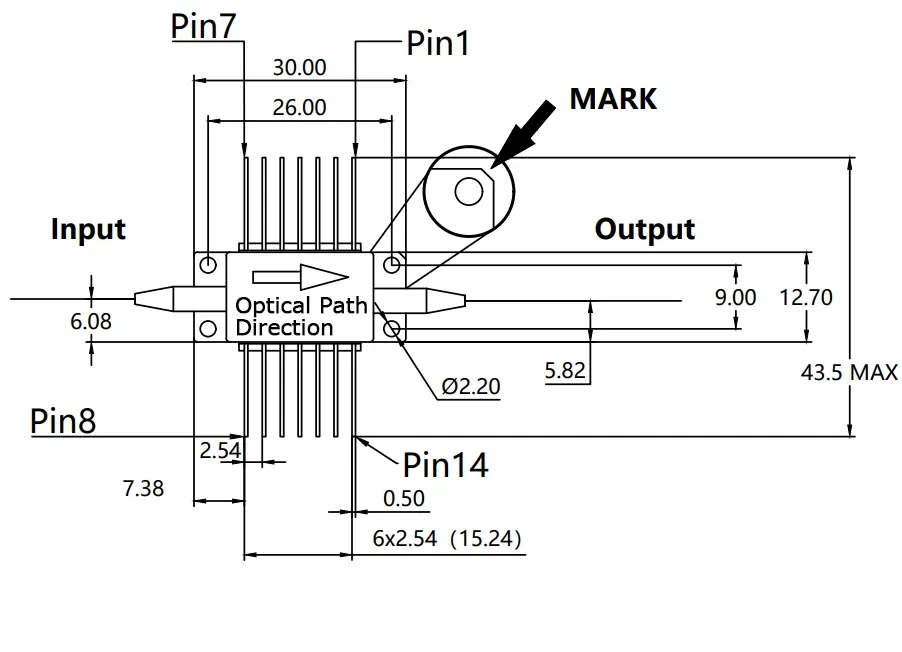
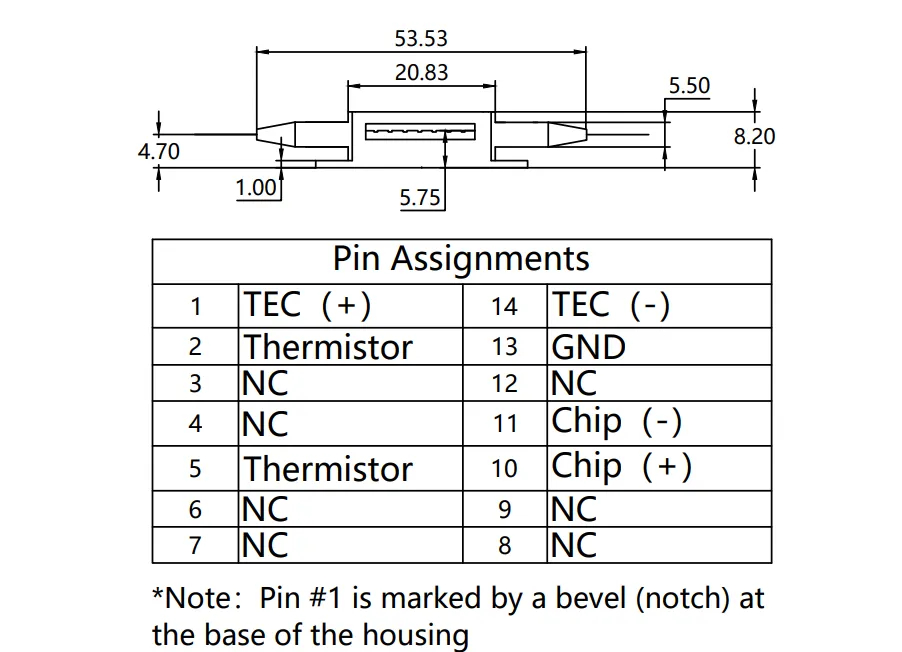
Typical Characteristic Curves
ASE spectra

ASE LIV characteristics
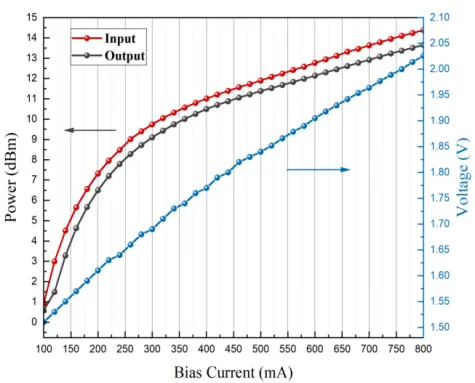
Gain vs. Output power
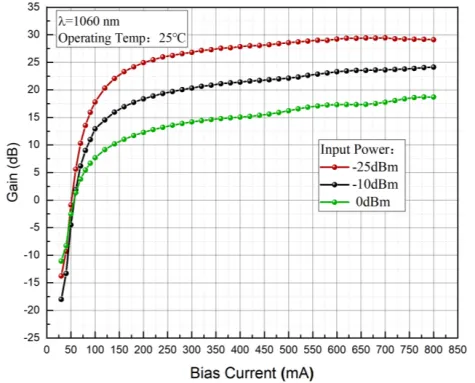
Gain spectra
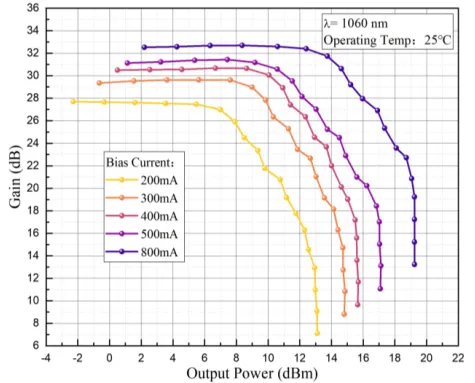

The semiconductor optical amplifier (SOA) series products are primarily used for amplifying optical signals, significantly enhancing the output optical power. These products feature high gain, low power consumption, and low polarization dependence. Additionally, this series adopts a sealed standard butterfly package and supports customization services.
Product Features
- Low noise and high sensitivity to meet amplification needs in PON operations.
- Low power consumption and high linearity to meet high-speed amplification needs such as inter-data center connections.
- Quick delivery response.
- Customization services: support for polarization maintaining, integration of isolators, integration of PD optical power monitors, and customization for highly integrated devices.
Product Applications
- 40G/100G LWDM optical signal amplification
- Optical testing
Product Specifications (Chip Temperature @ 25℃)
| Parameter | Symbol | Operating Conditions | Minimum Value | Typical Value | Maximum Value | Unit |
|---|---|---|---|---|---|---|
| ASE Central Wavelength | λASE | 25℃, If=120mA | --- | 1260 | --- | nm |
| Operating Wavelength | λ | 25℃, If=120mA | --- | 1270 | --- | nm |
| -3dB Gain Spectral Width | Δλ | Pin=-20dBm | 60 | --- | --- | nm |
| Maximum Optical Output | Pmax | If=120mA, Pin=5dBm@1270nm | 10 | --- | 13 | dBm |
| Small Signal Gain | SSG | If=120mA, Pin=-20dBm@1270nm | --- | 18 | --- | dB |
| Polarization Dependent Gain | PDG | 25℃, If=120mA | --- | 0.5 | 1.0 | dB |
| Noise Figure | NF | 25℃, If=120mA@1270nm | --- | 6 | 8 | dB |
| Operating Current | If | --- | --- | 120 | 250 | mA |
| Forward Voltage | Vf | --- | --- | 1.2 | 1.4 | V |
| TEC Current | ITEC | --- | --- | --- | 1.8 | A |
| TEC Voltage | VTEC | --- | --- | --- | 3.4 | V |
| Thermistor Resistance Value | Rtherm | T=25℃ | 9.5 | 10 | 10.5 | KΩ |
| Thermistor Current | Itherm | --- | --- | --- | 5 | mA |
| Hermeticity 1 | T=25℃ | 1×10-12 | 1×10-11 | 1×10-8 | Pa.m3/s | |
| Operating Temperature | TC | I=Iop | -10 | --- | 70 | ℃ |
| Storage Temperature | Tstg | --- | --- | 85 | ℃ | |
| Total Power Consumption | P | --- | --- | --- | 4 | W |
Structure Dimensions and Pin Definitions


Typical Characteristic Curves
ASE spectra
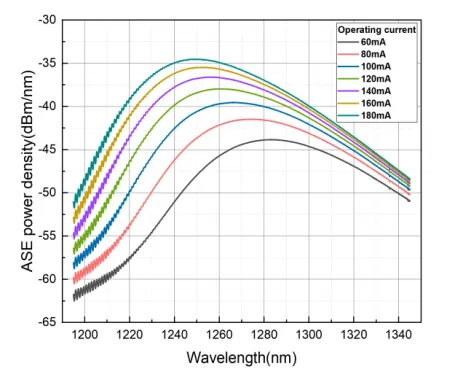
ASE LIV characteristics

Gain vs. Output power

Gain spectra

Gain vs. Current (different temperature)
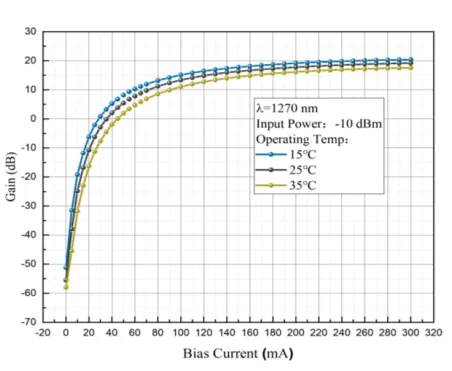
Gain vs. Current (different input power)


The Semiconductor Optical Amplifier (SOA) series products are primarily used for optical signal amplification, significantly enhancing output optical power. These products feature high amplification rates, low power consumption, and low polarization dependence, and they utilize proprietary chips. Additionally, this series adopts a sealed standard butterfly package and supports customization services.
Product Features
- Low power consumption with a typical driving current of 120mA, meeting the low power consumption requirements of high-speed ROSA.
- Supports temperature monitoring and TEC (Thermoelectric Cooling) for temperature control, ensuring stable operation across the entire temperature range.
- Customization services: Supports custom designs for highly integrated devices, including polarization-maintaining, integrated isolators, and optical power monitoring with PD (photodiode).
Product Applications
- Inter-data center connections, 40G/100G optical signal amplification
- Aggregation and distribution, 40G/100G optical signal amplification
- Applications in 100G 4-channel (LWDM) optical signal amplification
Product Specifications (Chip Temperature @ 25℃)
| Parameter | Symbol | Operating Conditions | Minimum Value | Typical Value | Maximum Value | Unit |
|---|---|---|---|---|---|---|
| ASE Central Wavelength | λASE | 25℃, If=120mA | --- | 1310 | --- | nm |
| Operating Wavelength | λ | 25℃, If=120mA | --- | 1310 | --- | nm |
| -3dB Gain Spectral Width | Δλ | Pin=-20dBm | --- | 65 | --- | nm |
| Maximum Optical Output | Pmax | If=120mA, Pin=5dBm@1310nm | --- | 13 | --- | dBm |
| Small Signal Gain | SSG | If=120mA, Pin=-20dBm@1310nm | --- | 16 | --- | dB |
| Polarization Dependent Gain | PDG | 25℃, If=120mA | --- | 0.5 | 1.0 | dB |
| Noise Figure | NF | 25℃, If=120mA@1310nm | --- | 7 | 9 | dB |
| Operating Current | If | --- | --- | 120 | 250 | mA |
| Forward Voltage | Vf | --- | --- | 1.2 | 1.4 | V |
| TEC Current | ITEC | --- | --- | --- | 1.8 | A |
| TEC Voltage | VTEC | --- | --- | --- | 3.4 | V |
| Thermistor Resistance Value | Rtherm | T=25℃ | 9.5 | 10 | 10.5 | KΩ |
| Thermistor Current | Itherm | --- | --- | --- | 5 | mA |
| Hermeticity 1 | T=25℃ | 1×10-12 | 1×10-11 | 1×10-8 | Pa.m3/s | |
| Operating Temperature | TC | I=If | -10 | --- | 70 | ℃ |
| Storage Temperature | Tstg | --- | --- | 85 | ℃ | |
| Total Power Consumption | P | --- | --- | --- | 4 | W |
Structure Dimensions and Pin Definitions


Typical Characteristic Curves
ASE spectra

ASE LIV characteristics

Gain vs. Output power

Gain spectra

Gain vs. Current (different temperature)

Gain vs. Current (different input power)


The Semiconductor Optical Amplifier (SOA) series products are mainly used for amplifying optical signals, significantly enhancing the output optical power. These products feature high amplification rates, low power consumption, and low polarization dependence, utilizing proprietary chips. Additionally, this series adopts a sealed standard butterfly package and offers customization services.
Product Features
- Low power consumption with a typical driving current of 120mA, meeting the low power consumption requirements of high-speed ROSA.
- Supports temperature monitoring and temperature control via TEC (thermoelectric cooling), ensuring stable operation across the full temperature range.
- Customization services: Supports custom designs for higher integration devices, such as polarization maintaining, integrated isolators, and optical power monitoring using PD (photodiodes).
Product Applications
- Inter-data center connections, 40G/100G optical signal amplification
- Aggregation and distribution, 40G/100G optical signal amplification
- Application in 100G 4-channel (LWDM) optical signal amplification
Product Specifications (Chip Temperature @ 25℃)
| Parameter | Symbol | Operating Conditions | Minimum Value | Typical Value | Maximum Value | Unit |
|---|---|---|---|---|---|---|
| ASE Central Wavelength | λASE | 25℃, If=250mA | --- | 1270 | --- | nm |
| Operating Wavelength | λ | 25℃, If=250mA | --- | 1310 | --- | nm |
| -3dB Gain Spectral Width | Δλ | Pin=-20dBm | --- | 65 | --- | nm |
| Maximum Optical Output | Pmax | If=250mA, Pin=5dBm@1310nm | --- | 15 | --- | dBm |
| Small Signal Gain | SSG | If=250mA, Pin=-25dBm@1310nm | --- | 25 | --- | dB |
| Polarization Dependent Gain | PDG | 25℃, If=250mA | --- | 0.5 | 1.0 | dB |
| Noise Figure | NF | 25℃, If=250mA@1310nm | --- | 7 | 9 | dB |
| Operating Current | If | --- | --- | 250 | 400 | mA |
| Forward Voltage | Vf | --- | --- | 1.2 | 1.5 | V |
| TEC Current | ITEC | --- | --- | --- | 1.8 | A |
| TEC Voltage | VTEC | --- | --- | --- | 3.4 | V |
| Thermistor Resistance Value | Rtherm | T=25℃ | 9.5 | 10 | 10.5 | KΩ |
| Thermistor Current | Itherm | --- | --- | --- | 5 | mA |
| Hermeticity 1 | T=25℃ | 1×10-12 | 1×10-11 | 1×10-8 | Pa.m3/s | |
| Operating Temperature | TC | I=If | -10 | --- | 70 | ℃ |
| Storage Temperature | Tstg | --- | --- | 85 | ℃ | |
| Total Power Consumption | P | --- | --- | --- | 4 | W |
Structure Dimensions and Pin Definitions


Typical Characteristic Curves
ASE spectra

ASE LIV characteristics

Gain vs. Output power

Gain spectra

Gain vs. Current (different temperature)

Gain vs. Current (different input power)
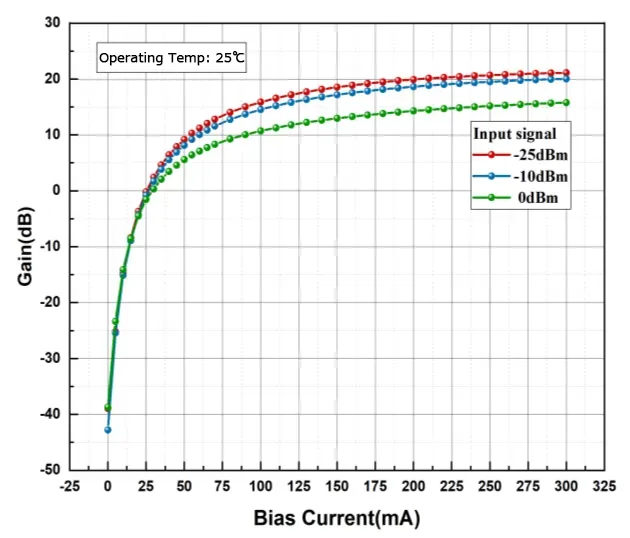

The Semiconductor Optical Amplifier (SOA) series products are primarily used for optical signal amplification, significantly enhancing the output optical power. These products feature high amplification rates, low power consumption, and low polarization dependence. Additionally, the series adopts a sealed standard butterfly package and supports customization services.
Product Features
- Features high amplification rate, low power consumption, low polarization-dependent loss, and high extinction ratio.
- Supports temperature monitoring and TEC (thermoelectric control), ensuring stable operation across the entire temperature range.
- Customization services: Compatible with advanced integration devices, including polarization maintaining, Faraday isolators, and integrated high-density PD optical power monitoring.
Product Applications
- In distributed optical fiber sensor systems, it is used as a replacement for acousto-optic modulators, functioning as a modulator/chopper.
- In broadband light sources, it is used as a broadband light source for applications such as demodulators for fiber gratings.
- In optical communication systems, it enables amplification of optical signals at a wavelength of 1550nm, serving as a replacement for certain EDFAs (Erbium-Doped Fiber Amplifiers).
- In wind measurement radar, spatial optical exploration, and space optical communication, it is combined with narrow-linewidth lasers to function as a MOPA laser (Master Oscillator + Power Amplifier).
Product Specifications
| Parameter | Symbol | Operating Conditions | Minimum Value | Typical Value | Maximum Value | Unit |
|---|---|---|---|---|---|---|
| ASE Central Wavelength | λASE | 25℃, If=250mA | --- | 1515 | --- | nm |
| Operating Wavelength | λ | 25℃, If=250mA | --- | 1550 | --- | nm |
| -3dB Gain Spectral Width | Δλ | Pin=0dBm | 100 | --- | --- | nm |
| Maximum Optical Output | Pmax | If=250mA, Pin=5dBm@1550nm | --- | 13 | --- | dBm |
| Small Signal Gain | SSG | If=250mA, Pin=-25dBm@1550nm | 25 | --- | dB | |
| Polarization Dependent Gain | PDG | 25℃, If=250mA | --- | 1.0 | 2.0 | dB |
| Noise Figure | NF | 25℃, If=250mA@1550nm | --- | 7 | 9 | dB |
| Operating Current | If | --- | --- | 250 | 400 | mA |
| Forward Voltage | Vf | --- | --- | 1.3 | 1.5 | V |
| Extinction Ratio1 | ER | If=250mA/If=0mA, Pin=0dBm | --- | 50 | --- | dB |
| Extinction Ratio2 | ER | If=250mA/If=5mA, Pin=0dBm | --- | 70 | --- | dB |
| TEC Current | ITEC | --- | --- | --- | 1.8 | A |
| TEC Voltage | VTEC | --- | --- | --- | 3.4 | V |
| Thermistor Resistance Value | Rtherm | T=25℃ | 9.5 | 10 | 10.5 | KΩ |
| Thermistor Current | Itherm | --- | --- | --- | 5 | mA |
| Hermeticity 1 | T=25℃ | 1×10-12 | 1×10-11 | 1×10-8 | Pa.m3/s | |
| Operating Temperature | TC | I=Iop | -10 | --- | 70 | ℃ |
| Storage Temperature | Tstg | --- | --- | 85 | ℃ | |
| Total Power Consumption | P | --- | --- | --- | 4 | W |
Structure Dimensions and Pin Definitions


Typical Characteristic Curves
ASE spectra

ASE LIV characteristics

Gain vs. Output power

Gain spectra

Gain vs. Current (different temperature)

Gain vs. Current (different input power)


The Semiconductor Optical Amplifier (SOA) series products are primarily used for optical signal amplification, significantly enhancing the output optical power. They feature high gain, low power consumption, and low polarization dependence, utilizing a proprietary chip design. Additionally, the series adopts a sealed standard butterfly package and supports customization services.
Product Features
- Features high gain, low power consumption, low polarization-dependent loss, high output optical power (20dBm), and high extinction ratio.
- ASE (Amplified Spontaneous Emission) optical power reaches up to 40mW, making it suitable for broadband light sources.
- Supports temperature monitoring and TEC (Thermoelectric Cooling) control, ensuring stable operation across the entire temperature range.
Product Applications
- In distributed optical fiber sensor systems, it is used as a replacement for acousto-optic modulators, functioning as a modulator/chopper.
- In broadband light sources, it is used as a broadband light source for applications such as demodulators for fiber gratings.
- In optical communication systems, it enables amplification of optical signals at a wavelength of 1550nm, serving as a replacement for certain EDFAs (Erbium-Doped Fiber Amplifiers).
- In wind measurement radar, space optical exploration, and space optical communication, it is combined with narrow-linewidth lasers to function as a MOPA (Master Oscillator + Power Amplifier) laser.
Product Specifications
| Parameter | Symbol | Operating Conditions | Minimum Value | Typical Value | Maximum Value | Unit |
|---|---|---|---|---|---|---|
| ASE Central Wavelength | λASE | 25℃, If=1000mA | --- | 1520 | --- | nm |
| Operating Wavelength | λ | 25℃, If=1000mA | --- | 1550 | --- | nm |
| -3dB Gain Spectral Width | Δλ | Pin=-10dBm, If=1000mA | --- | 90 | --- | nm |
| Maximum Optical Output | Pmax | If=1000mA, Pin=5dBm@1550nm | 21 | --- | --- | dBm |
| Small Signal Gain | SSG | If=1000mA, Pin=-25dBm@1550nm | 30 | 35 | --- | dB |
| Polarization Dependent Gain | PDG | 25℃, If=1000mA | --- | 12 | --- | dB |
| Noise Figure | NF | 25℃, If=1000mA@1550nm | --- | 6 | 8 | dB |
| Operating Current | If | --- | --- | 1000 | 1300 | mA |
| Forward Voltage | Vf | --- | --- | 1.5 | 2 | V |
| Extinction Ratio | ER | If=1000mA/If=0mA, Pin=0dBm | --- | 60 | --- | dB |
| TEC Current | ITEC | --- | --- | --- | 1.8 | A |
| TEC Voltage | VTEC | --- | --- | --- | 3.4 | V |
| Thermistor Resistance Value | Rtherm | T=25℃ | 9.5 | 10 | 10.5 | KΩ |
| Thermistor Current | Itherm | --- | --- | --- | 5 | mA |
| Hermeticity 1 | T=25℃ | 1×10-12 | 1×10-11 | 1×10-8 | Pa.m3/s | |
| Operating Temperature | TC | I=Iop | -10 | --- | 70 | ℃ |
| Storage Temperature | Tstg | --- | --- | 85 | ℃ | |
| Total Power Consumption | P | --- | --- | --- | 5 | W |
Structure Dimensions and Pin Definitions


Typical Characteristic Curves
ASE spectra

ASE LIV characteristics

Gain vs. Output power

Gain spectra

Gain vs. Current (different temperature)

Gain vs. Current (different input power)


JBO-007 1550nm-23dBm-Butterfly-Type-Ultra-High-Power SOA Semiconductor Optical Amplifier (SOA) series products are primarily used for optical signal amplification, significantly enhancing output optical power. They feature high amplification rate, low power consumption, and low polarization dependence, utilizing a proprietary chip design. Additionally, the series adopts a sealed standard butterfly package and supports customization services.
Product Features
- Features high amplification rate, low power consumption, low polarization-dependent loss, high output optical power (25dBm), and high extinction ratio.
- Supports temperature monitoring and TEC (Thermoelectric Control), ensuring stable operation across the entire temperature range.
- Customization services: Capable of custom designs for advanced integrated devices such as polarization-maintaining, integrated isolators, and integrated PD optical power monitoring.
Product Applications
- Used as a replacement for acousto-optic modulators in distributed optical fiber sensor systems, functioning as a modulator/chopper.
- Applied in broadband light sources, such as broadband light sources for demodulators of fiber gratings.
- Enables the amplification of optical signals at a wavelength of 1550nm in optical communication systems and is used as a replacement for certain EDFAs (Erbium-Doped Fiber Amplifiers).
- Applied in wind speed measurement radar, space optical exploration, and space optical communication, and used in combination with narrow-linewidth lasers as a MOPA laser.
Product Specifications (Chip Temperature @ 25℃)
| Parameter | Symbol | Operating Conditions | Minimum Value | Typical Value | Maximum Value | Unit |
|---|---|---|---|---|---|---|
| ASE Central Wavelength | λASE | 25℃, If=1000mA | --- | 1490 | --- | nm |
| Operating Wavelength | λ | 25℃, If=1000mA | --- | 1550 | --- | nm |
| -3dB Gain Spectral Width | Δλ | Pin=-10dBm, If=1000mA | --- | 100 | --- | nm |
| Maximum Optical Output | Pmax | If=1000mA, Pin=5dBm@1550nm | --- | 23 | --- | dBm |
| Small Signal Gain | SSG | If=1000mA, Pin=-25dBm@1550nm | 30 | 35 | --- | dB |
| Polarization Dependent Gain | PDG | 25℃, If=1000mA | --- | 12 | --- | dB |
| Noise Figure | NF | 25℃, If=1000mA@1550nm | --- | 6 | 8 | dB |
| Operating Current | If | --- | --- | 1000 | 1200 | mA |
| Forward Voltage | Vf | --- | --- | 2.4 | 2.6 | V |
| Extinction Ratio | ER | If=1000mA/If=0mA, Pin=0dBm | --- | 35 | --- | dB |
| TEC Current | ITEC | --- | --- | --- | 1.8 | A |
| TEC Voltage | VTEC | --- | --- | --- | 3.4 | V |
| Thermistor Resistance Value | Rtherm | T=25℃ | 9.5 | 10 | 10.5 | KΩ |
| Thermistor Current | Itherm | --- | --- | --- | 5 | mA |
| Hermeticity 1 | T=25℃ | 1×10-12 | 1×10-11 | 1×10-8 | Pa.m3/s | |
| Operating Temperature | TC | I=Iop | -10 | --- | 50 | ℃ |
| Storage Temperature | Tstg | --- | --- | 85 | ℃ | |
| Total Power Consumption | P | --- | --- | --- | 6 | W |
Product Applications


Product Specifications
ASE spectra

ASE LIV characteristics

Gain vs. Output power

Gain spectra

Gain vs. Current (different temperature)

Gain vs. Current (different input power)


The Semiconductor Optical Amplifier (SOA) series products are primarily used for optical signal amplification, significantly enhancing output optical power. These products feature high gain, low power consumption, and low polarization dependence. Additionally, the series adopts a sealed standard butterfly package and supports product customization services.
Product Applications
- Applied as a broadband light source, for example, used as a light source for fiber grating demodulators.
- Applied in optical communication systems to amplify optical signals in the C+L wavelength bands, serving as a replacement for certain EDFA applications.
Product Specifications (Chip Temperature @ 25℃)
| Parameter | Symbol | Operating Conditions | Minimum Value | Typical Value | Maximum Value | Unit |
|---|---|---|---|---|---|---|
| Operating Wavelength | λ | 25℃, If=300mA | --- | 1560 | --- | nm |
| -3dB Bandwidth | Δλ | 25℃, If=300mA | --- | 120 | --- | nm |
| Maximum Optical Output | Psat | If=300mA, Pin=5dBm@1550nm | --- | 13 | --- | dBm |
| Small Signal Gain | G | If=300mA, Pin=-25dBm@1550nm | --- | 25 | --- | dB |
| Polarization Dependent Gain | PDG | 25℃, If=300mA | --- | 6 | --- | dB |
| Noise Figure | NF | 25℃, If=300mA, Pin=10dBm | --- | 7 | --- | dB |
| Operating Current | If | --- | --- | 300 | 500 | mA |
| Forward Voltage | Vf | --- | --- | 1.6 | 2 | V |
| Extinction Ratio | ER1 | If=300mA/If=0mA, Pin=0dBm | --- | 55 | --- | dB |
| Extinction Ratio | ER2 | If=300mA/If=5mA, Pin=0dBm | --- | 70 | --- | dB |
| TEC Current | ITEC | --- | --- | --- | 1.8 | A |
| TEC Voltage | VTEC | --- | --- | --- | 3.4 | V |
| Thermistor Resistance Value | Rtherm | T=25℃ | 9.5 | 10 | 10.5 | KΩ |
| Thermistor Current | Itherm | --- | --- | --- | 5 | mA |
| Hermeticity 1 | T=25℃ | 1×10-12 | 1×10-11 | 1×10-8 | Pa.m3/s | |
| Operating Temperature | TC | I=Iop | -10 | --- | 70 | ℃ |
| Storage Temperature | Tstg | --- | --- | 85 | ℃ | |
| Total Power Consumption | P | --- | --- | --- | 4 | W |
Structure Dimensions and Pin Definitions


Typical Characteristic Curves
ASE spectra

ASE LIV characteristics

Gain vs. Output power

Gain spectra

Gain vs. Current (different temperature)

Gain vs. Current (different input power)
